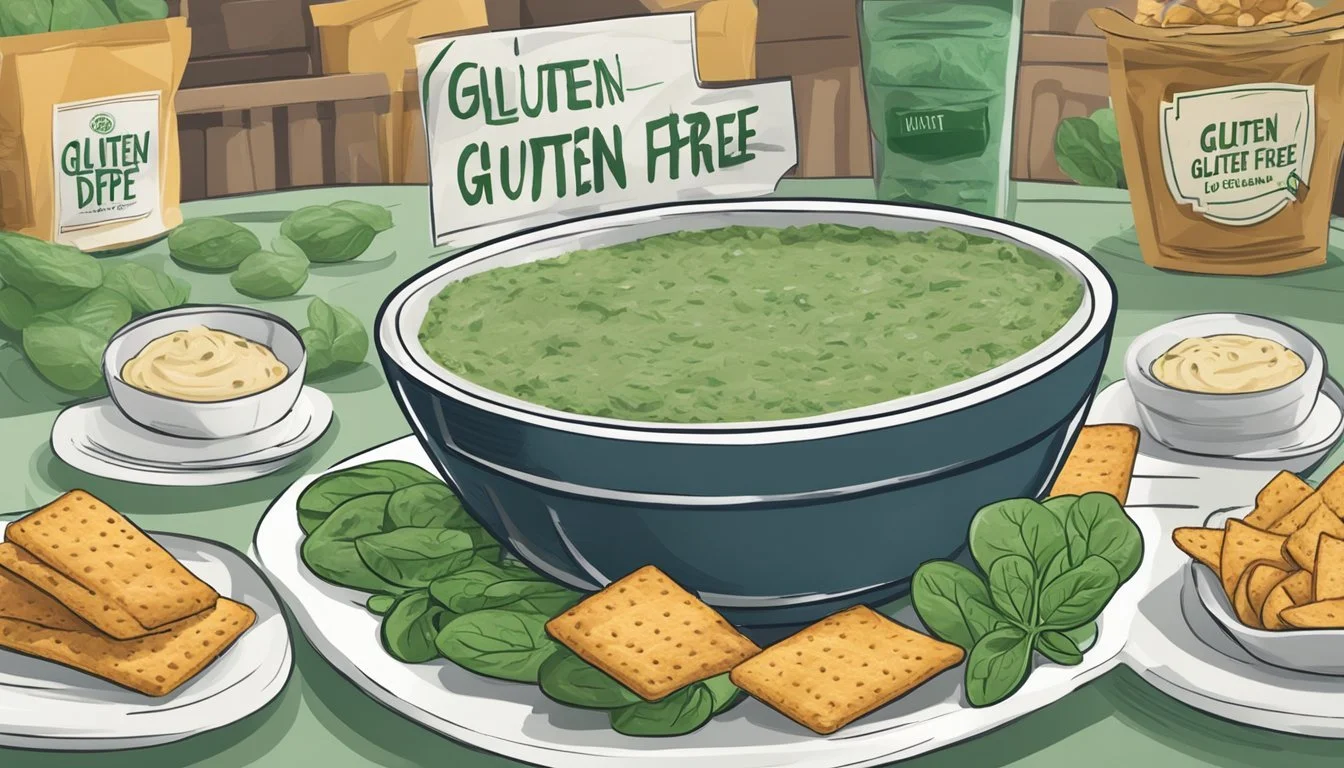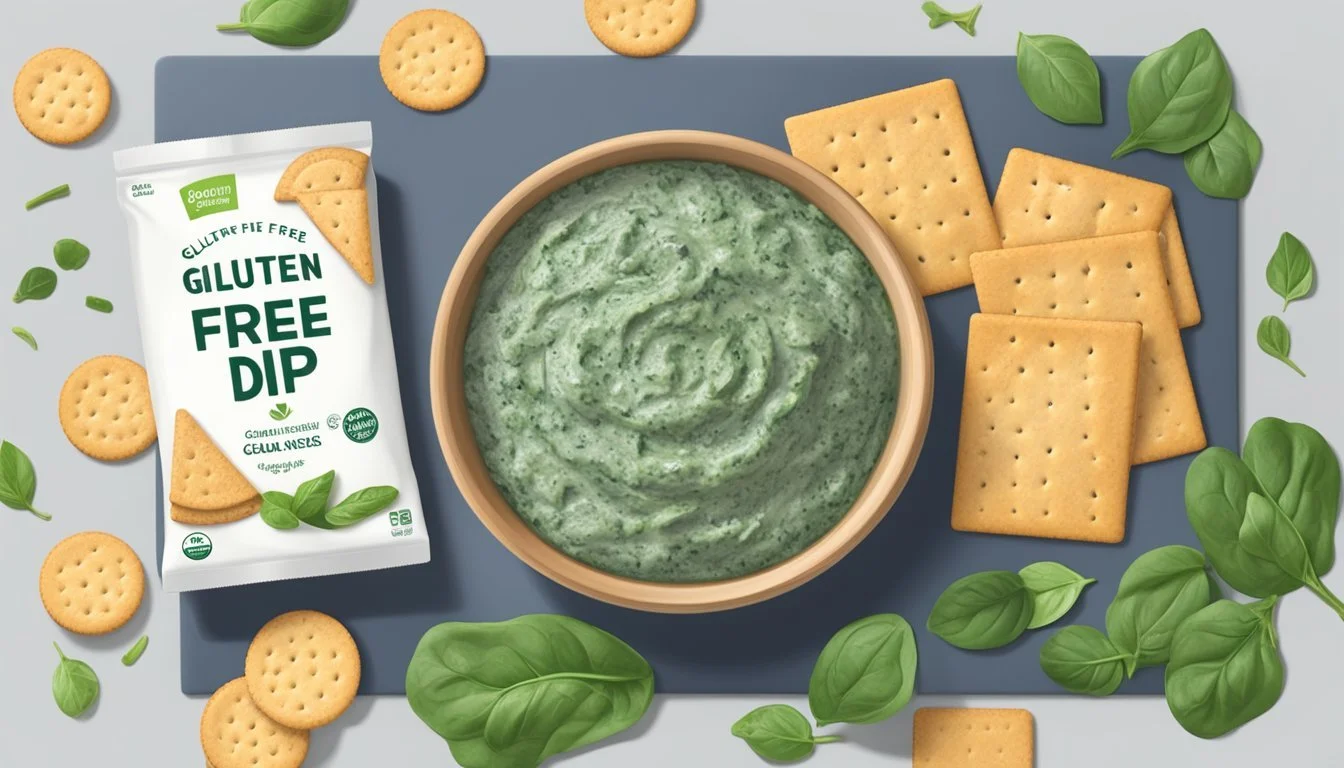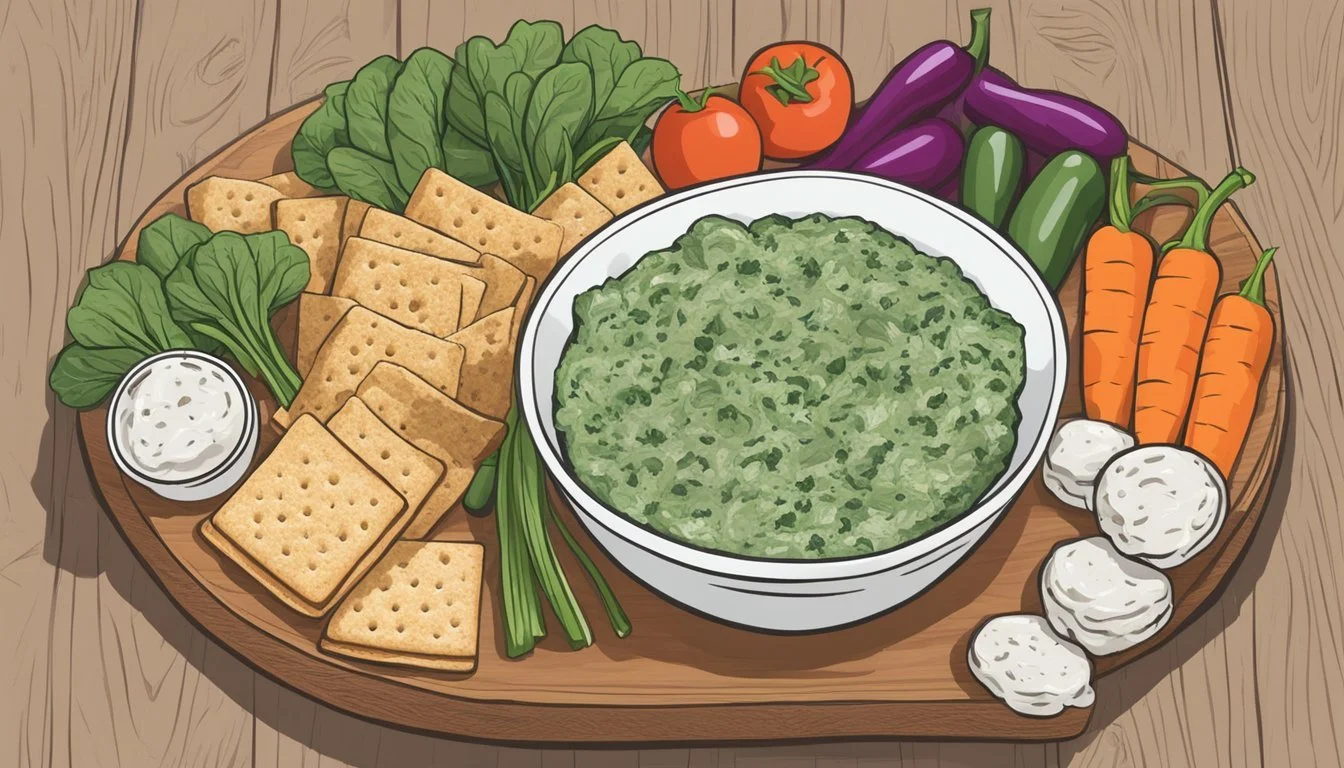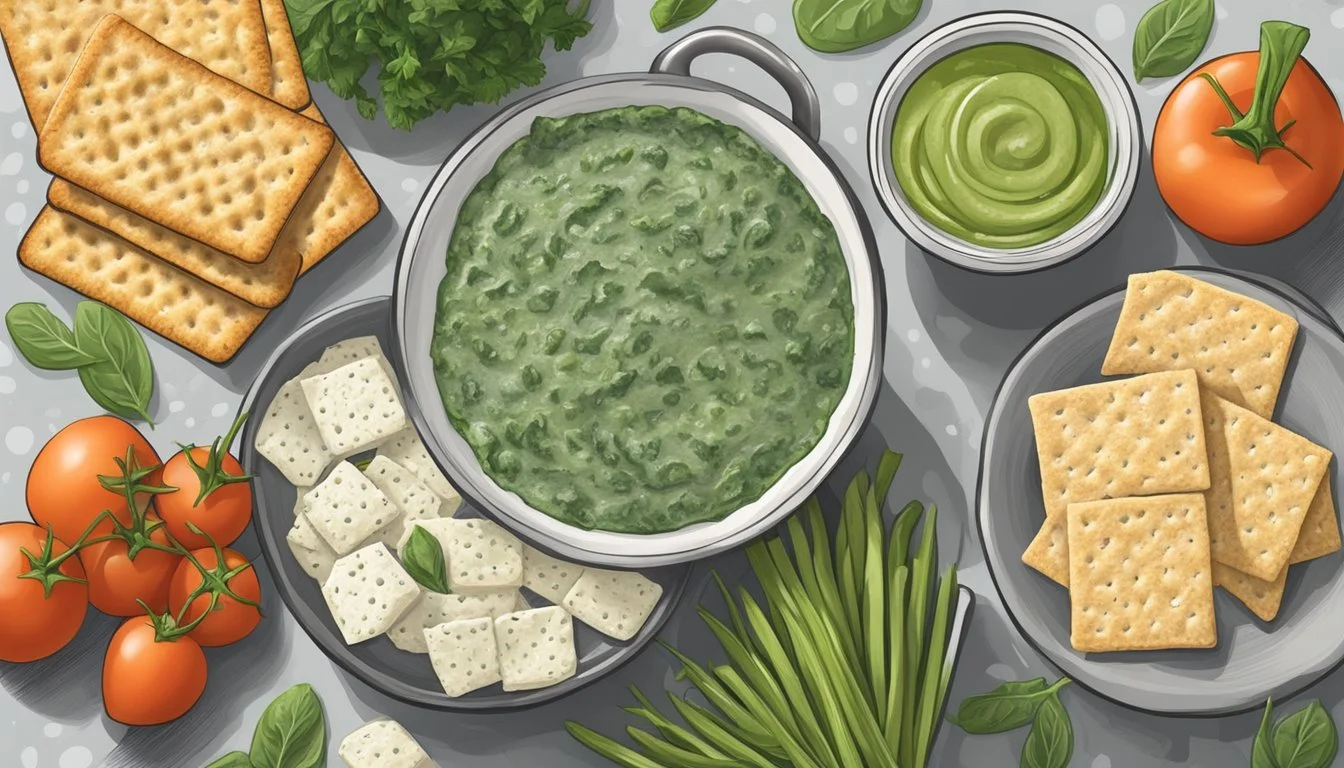Is Spinach Dip Gluten-Free?
Unveiling the Truth About This Popular Appetizer
When considering the dietary needs of individuals with gluten sensitivities or celiac disease, the question of whether spinach dip is gluten-free is quite pertinent. The classic spinach (What wine goes well with spinach?) dip, a beloved party staple known for its creamy texture and savory flavor, can vary in terms of ingredients, with some recipes containing gluten and others being naturally gluten-free. Careful consideration is necessary to determine the gluten content, particularly because the dish can contain hidden sources of gluten in additives or accompaniments like bread and crackers.
To ensure a spinach dip is gluten-free, one must examine each ingredient in the recipe starting with the base—often made with mayonnaise, sour cream, or cream cheese—which is typically gluten-free. However, when flavors and seasonings like soup mixes or packaged spices are added to enhance taste, they can introduce gluten. This makes label checking essential. Gluten-free spinach dips also avoid using flour as a thickener, relying instead on the natural consistency of the base ingredients or gluten-free alternatives.
Furthermore, serving options for a gluten-free spinach dip should be free from gluten. Traditional dippers like bread, crackers, and chips often contain gluten unless specifically labeled otherwise. To accommodate all dietary restrictions, opting for cut vegetables or gluten-free alternatives as dippers is a safe and inclusive choice. With the growing availability of gluten-free products and an awareness of ingredient details, hosting a gathering with spinach dip that everyone can enjoy becomes a simple task.
Understanding Spinach Dip
In the context of whether spinach dip is gluten-free, it is important to scrutinize the typical components that make up this popular appetizer.
What Is Spinach Dip?
Spinach dip, often featured as a classic appetizer at gatherings and restaurants, is a creamy and savory blend that usually highlights spinach as its primary ingredient. It takes the form of a thick sauce into which various foods such as bread, chips, and vegetables are dipped. The creaminess of spinach dip is traditionally achieved through the addition of dairy-based ingredients, and its flavor is enhanced with aromatic vegetables like garlic and onion, as well as seasonings.
Key Ingredients in Traditional Spinach Dip
The traditional spinach dip recipe consists of several key ingredients, each contributing to the overall taste and texture:
Spinach: Either fresh or frozen, spinach is sautéed or defrosted and then chopped or left whole according to the recipe's specifications.
Dairy Components: Often include:
Sour cream: Adds a tangy richness.
Cream cheese: Provides a smooth, creamy base.
Mayonnaise: Offers a velvety texture and slight acidic note.
Cheeses: Typically involves:
Parmesan cheese: Contributes a nutty, salty flavor.
Mozzarella or other meltable cheeses: Used for baked dips to achieve a gooey texture.
Seasonings: A blend of:
Garlic: Either fresh, powdered, or minced, garlic imparts a pungent flavor.
Onion: Adds sweetness and depth, often used in dehydrated form for a subtler taste.
Salt and pepper: Adjust to enhance the overall seasoning of the dip.
This combination of ingredients often results in a rich and comforting dip, although variations exist depending on individual recipes and dietary preferences.
Gluten-Free Considerations
When preparing a gluten-free spinach dip, it is vital to understand what gluten-free truly means and to be aware of ingredients commonly found in spinach dips that may contain gluten. By avoiding certain items, individuals with gluten sensitivities can safely enjoy this dish.
What Does Gluten-Free Mean?
Being gluten-free means that a food product does not contain gluten, a protein found in wheat, barley, and rye. For individuals with celiac disease or gluten intolerance, consuming gluten can lead to adverse health effects, making it essential to ensure that all ingredients in the spinach dip are free from these grains.
Common Gluten Sources in Spinach Dip
Spinach dip may include hidden sources of gluten, originating from additives or thickeners used to enhance texture and flavor. Components such as bouillon cubes, some spice blends, or store-bought seasoning packets may contain gluten and should be inspected closely. Additionally, if the dip is traditionally served in a bread bowl, ensuring that the bread is made from gluten-free flour is crucial.
Ingredients to Avoid
When assembling a gluten-free spinach dip, certain ingredients commonly used in recipes or as accompaniments should be avoided or substituted with gluten-free alternatives:
Bread Products: Avoid regular bread bowls and crackers. Opt for items labeled as gluten-free.
Thickeners: Some recipes use flour as a thickener. Substitute with cornstarch or a gluten-free flour blend.
Seasoning Mixes: Pre-made seasoning mixes may contain gluten. Check labels, or use individual herbs and spices.
By considering these factors, anyone can prepare a delicious, gluten-free spinach dip that is safe for individuals with gluten sensitivities.
Customizing Spinach Dip for Dietary Needs
Spinach dip can be a delicious, crowd-pleasing appetizer - but those with specific dietary needs might feel left out. With some modifications, spinach dip can be adapted to suit dairy-free and low-carb diets without compromising taste.
Dairy-Free Adaptations
For those avoiding dairy, traditional ingredients like sour cream and cream cheese can be replaced with their dairy-free counterparts. Using dairy-free cream cheese and sour cream alternatives made from almond, soy, coconut, or cashews ensures the dip remains creamy and flavorful. Vegans can enjoy the dip by ensuring that all ingredients, such as mayonnaise, are vegan-friendly.
To replace cheese:
Opt for nutritional yeast or vegan cheese shreds for a similar cheesy flavor.
Check the labels for gluten-containing additives when selecting dairy-free alternatives.
Low-Carb and Keto Options
Individuals following a low-carb or keto diet can still enjoy spinach dip by making a few adjustments. It's important to select ingredients that are low in carbohydrates but still provide a satisfying taste and texture.
Replace traditional crackers and bread with low-carb vegetables like cucumber slices, bell pepper strips, or celery.
Prepare the dip with full-fat cream cheese and sour cream to stay within the keto-friendly fat macros.
Remember that many store-bought mayonnaise brands are low-carb but check for added sugars. To further ensure the dip meets keto standards, one might consider making homemade mayonnaise.
Preparation Techniques
When crafting a gluten-free spinach dip, one must pay close attention to the preparation techniques. The type of spinach selected, the method used to combine ingredients, and the cooking approach all contribute to the dip's final taste and texture.
Choosing Fresh or Frozen Spinach
Whether one opts for fresh or frozen spinach, both can yield a delicious gluten-free dip. For fresh spinach, it's crucial to wash the leaves thoroughly to remove any debris before chopping them finely. Frozen spinach is convenient and requires thawing – usually in the refrigerator overnight or quickly in a microwave. After thawing, one must diligently drain any excess liquid to prevent a watery dip.
Optimal Mixing Methods
A proper mixing bowl is essential for blending dip ingredients uniformly. A spatula or an electric mixer ensures that the mayonnaise and sour cream integrate smoothly. When adding spices, consistent stirring helps distribute flavors evenly. For an even mix, some prefer using their hands, especially when combining denser ingredients to ensure everything is well incorporated.
Baking and Cooking Tips
For a hot spinach dip, preheating an oven to the right temperature is vital – typically around 375ºF. A greased baking dish or cast iron skillet suits this purpose and ensures that the dip bakes evenly. When using a skillet on the stove, one should cook spinach with a bit of water until wilted, ensuring it remains tender without becoming dry. For dips that are served cold, no cooking is necessary, and the prepared mixture is chilled until serving.
Serving and Pairing Suggestions
When choosing the right accompaniments for spinach dip, one should consider items that complement the creamy texture and rich flavor. Options for dippers should not only cater to taste preferences but also to dietary needs, such as gluten sensitivity.
Gluten-Free Dippers
Tortilla Chips: A classic choice, tortilla chips are often gluten-free and provide a satisfying crunch.
Fresh Veggies: Carrots, cucumbers, and bell peppers (What wine goes well with bell peppers?) offer a contrasting crispness and are naturally free from gluten.
Gluten-Free Crackers: Available at most grocery stores, these provide a similar experience to traditional crackers without the gluten.
Corn Chips: Another gluten-free option, corn chips are sturdy and flavorful, making them ideal for dipping.
One can explore a variety of textures and flavors with these dippers, from the robust crunch of tortilla and corn chips to the refreshing crispness of fresh vegetables.
Creative Presentation Ideas
Gluten-Free Bread Bowl: Serve the spinach dip in a hollowed-out gluten-free bread bowl for an impressive presentation.
Veggie Platter: Arrange an assortment of fresh vegetables like carrot sticks, cucumber slices, and bell pepper strips artistically around the dip.
Layered Dip Tray: Layer the spinach dip with other gluten-free dips and top with a layer of gluten-full options, separated distinctly to prevent cross-contamination.
By incorporating these presentation ideas, the spinach dip can be the centerpiece of the table, encouraging guests to indulge in a variety of gluten-free dippers.
Storage and Food Safety
When it comes to storing spinach dip, one must prioritize food safety to ensure the dip remains safe to consume and retains its quality. The key to proper storage includes using airtight containers, regulating temperature, and following guidelines for freezing and reheating.
Storing Leftover Spinach Dip
Leftover spinach dip should be promptly stored in the refrigerator to prevent bacterial growth. An individual should transfer the dip to an airtight container and place it in the coldest part of the refrigerator, generally the back. Proper storage can keep the dip fresh for up to 3-5 days. A concise tracking of when the dip was first prepared is recommended for safety.
Freezing and Thawing Guidelines
For longer storage, spinach dip can be frozen. To freeze, one should place the well-sealed airtight container of dip into the freezer. It is best to label the container with the current date. The spinach dip will remain at optimal quality in the freezer for about 1-2 months. When ready to use, the dip should be thawed in the refrigerator overnight to ensure even thawing and maintain texture.
Reheating for Best Quality
If one wishes to reheat the spinach dip, they should do so gradually, either in a microwave or oven, until just heated through. This process helps to retain the dip's creamy texture and prevents it from separating. If using a microwave, stirring every 30 seconds is advised. For oven reheating, covering the dip with foil can prevent drying out. Always ensure the dip reaches a safe temperature before serving, which is 165°F as recommended for food safety.
Nutritional Information
When considering the nutritional value of spinach dip, it's important to consider both its caloric content and the inherent health benefits of the ingredients used. Spinach dip can be a nutritious option, especially when prepared with attention to ingredient quality.
Caloric Content
The caloric content of spinach dip varies depending on the specific recipe and portion size. Typically, a serving size of homemade spinach dip contains approximately:
Calories: 100-150 per 1/4 cup serving
This estimate can increase or decrease with the types of ingredients used, such as full-fat vs low-fat sour cream or mayonnaise.
Health Benefits of Spinach Dip
Spinach dip can provide several nutritional benefits:
Fiber: Spinach is a good source of dietary fiber, which supports digestive health.
Vitamin C: This vitamin, present in spinach, aids in the immune system's function and acts as an antioxidant.
Iron: Spinach provides iron, which is crucial for blood production and oxygen transport in the body.
Potassium: Potassium in spinach helps regulate fluid balance and supports heart function.
Keep in mind that for individuals with gluten sensitivities, ensuring that all ingredients are gluten-free is essential to enjoying these health benefits without adverse effects.
Recipes and Variations
Spinach dip is a beloved party favorite, and those opting for gluten-free options need not miss out. There are plenty of recipes and innovative twists on the classic that cater to gluten-sensitive palates while maintaining the deliciousness of the original dish.
Classic Gluten-Free Spinach Dip Recipe
A traditional gluten-free spinach dip typically involves a base of mayonnaise and sour cream blended with finely chopped spinach. It's essential to ensure that all ingredients, such as spice blends or packaged spinach, are certified gluten-free to avoid cross-contamination. The dip can be served cold, perfect for dipping with gluten-free bread, chips, or fresh vegetables. For a warm dip, one can mix in cream cheese and mozzarella, then bake until bubbly.
Ingredients:
1 cup mayonnaise (gluten-free)
1 cup sour cream (gluten-free)
2 cups chopped spinach (thawed and drained if frozen)
Spices (salt, pepper, garlic powder, etc.)
Instructions:
Mix mayonnaise and sour cream in a bowl.
Stir in spices and chopped spinach.
Refrigerate or bake as desired.
Innovative Spinach Dip Twists
For those who enjoy a bit of creativity in their cooking, spinach dip can be variously adapted using gluten-free ingredients. One popular variation is to incorporate artichokes, (What wine goes well with artichokes?) either by using canned artichokes or by adding freshly cooked ones. For a dairy-free version, alternatives like vegan mayonnaise and dairy-free cream cheese can be used. To make a hot spinach dip, the mixture is typically supplemented with cheeses like mozzarella or parmesan and then heated until warm and melty.
Add: 1 cup chopped artichokes (gluten-free)
To make it hot:
Bake: After mixing in cheeses, bake at 375ºF until the top is golden brown.
Dairy-Free Alternative:
Replace dairy ingredients with suitable vegan options.
When creating a homemade gluten-free spinach dip, the key is to use ingredients that are safe for gluten-sensitive individuals. Whether it is the classic cold dip or a hot, cheesy variation, one can easily customize the recipe for parties or personal enjoyment while keeping it gluten-free.
Hosting and Social Sharing
When hosting an event or sharing culinary creations online, it's important to consider the dietary needs of guests and followers. Ensuring that appetizers (What wine goes well with appetizers?) like spinach dip are gluten-free can make them a crowd-pleaser at parties and a popular share on social media platforms.
Serving at Parties and Gatherings
For individuals hosting parties, offering a gluten-free spinach dip can cater to guests with diverse dietary preferences. One should include common dip accompaniments that are also gluten-free, such as:
Crudité platters: A colorful selection of fresh vegetables like carrots, cucumber, and bell peppers.
Gluten-free crackers or bread: Provide a variety for guests to choose from.
Chips: Offer a mix of plain corn chips and gluten-free flavored varieties.
Pro Tip: Enhance the flavor of your gluten-free spinach dip by adding crispy bacon bits, a sprinkle of red pepper flakes for heat, or a mix of spices that complement the spinach. Don't forget to mix in minced garlic, chopped green onions, chestnuts, and a dash of gluten-free Worcestershire sauce for added depth.
Sharing Your Creations Online
If one decides to share their gluten-free spinach dip creation on social media, considering the visual presentation and the platform being used is crucial. Here are a few tips for each platform:
Instagram: A well-styled photo of the spinach dip with a vibrant array of dippers can make it visually appealing. One can share the recipe in the caption, highlighting gluten-free ingredients.
Facebook: A step-by-step video or a gallery of images illustrating the process can engage viewers. Like on Instagram, one should mention the addition of specific gluten-free elements.
Pinterest: Create a pin with an attractive photo and tie it to a blog post or recipe page with clear instructions and information about being a gluten-free option.
Remember to use hashtags like #GlutenFreeAppetizer or #HealthyDip to reach a wider audience who might be looking for gluten-free party snacks. Sharing the personal touch, like using a family recipe or a unique twist on the traditional spinach dip, can also make the post more engaging.
Final Tips and Tricks
When crafting a gluten-free spinach dip, attention to texture and flavor is paramount. The right techniques can elevate this side dish from good to unforgettable.
Achieving the Perfect Texture
To avoid a watery dip, one must thoroughly drain the spinach. After cooking, the spinach should be placed in a colander and pressed with a paper towel to remove excess water. This step ensures that the spinach integrates well without diluting the dip's creamy consistency. Next, to achieve optimum richness, blend mayonnaise (preferably full-fat for creamier texture) and sour cream evenly. For a stringy, satisfying cheese pull, add freshly grated mozzarella and parmesan cheeses, which melt well and contribute to a thicker texture.
Enhancing Flavors and Spices
The flavor profile of spinach dip can be enhanced by adding umami and depth with onion powder, garlic powder, and ground black pepper. For a fresh element, consider incorporating finely chopped parsley. It's crucial to taste and adjust—start with small amounts of spices and incrementally add until the flavor is well-balanced. Some individuals may prefer a hint of sweetness to counterbalance the savory; a pinch of sugar can be introduced to achieve that effect. As a rule of thumb, all ingredients should be well-incorporated, ensuring every bite is flavorful. Serve with gluten-free pretzels or a fresh vegetable medley for dipping.











